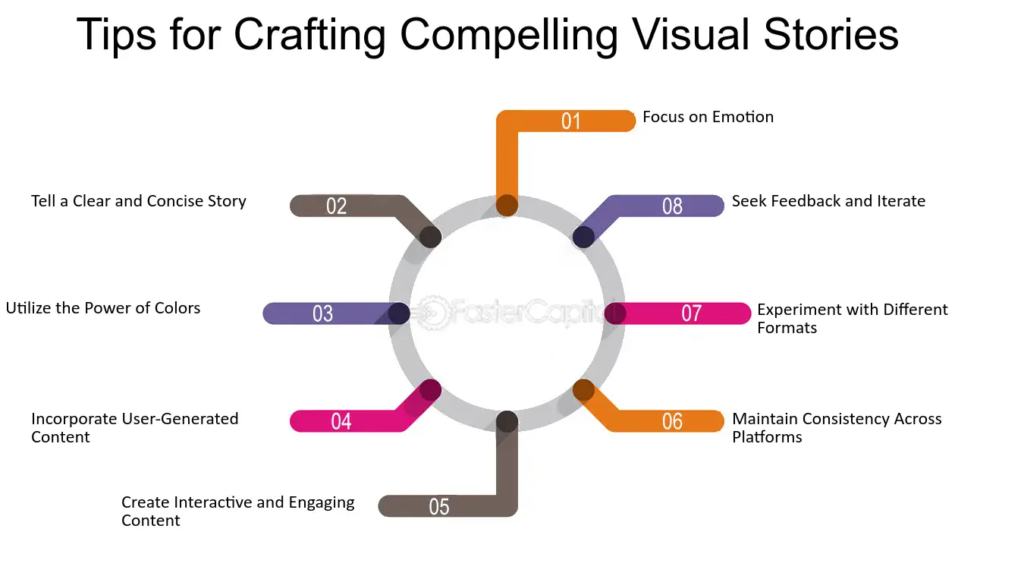Visual storytelling is a powerful tool that can captivate audiences and convey complex ideas. In today’s digital age, mastering visual storytelling is more important than ever, as attention spans are getting shorter and competition for attention is fierce.
The Creative Suite is a collection of professional design and editing software that offers a wide range of tools and features that can help unleash your creative power and bring your ideas to life.
Whether you are a marketer, an entrepreneur, or a creative professional, learning how to master visual storytelling with the Creative Suite can give you a competitive edge and help you communicate your ideas effectively.
In this blog, we will explore the fundamentals of visual storytelling, and share tips and techniques for using the Creative Suite to create engaging and impactful visuals. So, if you’re ready to take your storytelling skills to the next level, read on!

2. The power of visual storytelling in today’s digital age
In today’s digital age, where information overload is the norm, capturing and retaining your audience’s attention has become increasingly challenging. That’s where visual storytelling comes in. The power of visual storytelling lies in its ability to break through the noise and engage your audience instantly. Images can convey complex ideas and emotions in a way that words alone cannot.
Research has shown that visual content is processed faster by the human brain and is more likely to be remembered. Studies have found that people remember 65% of the information presented to them visually compared to only 10% when presented verbally.
With the Creative Suite, you have a powerful set of tools at your fingertips to create and enhance your visual storytelling. From graphic design in Photoshop and Illustrator to video editing in Premiere Pro and After Effects, the possibilities are endless. The Creative Suite allows you to combine visuals, text, and audio to create a cohesive narrative and elevate your narrative that captures your audience’s imagination.
In the next section, we will delve deeper into the principles of visual storytelling and explore how you can leverage the Creative Suite to create visually compelling narratives that resonate with your audience. Stay tuned!

3. Introducing the Creative Suite: a game-changer for visual storytellers
The Creative Suite is a game-changer for visual storytellers. With its wide range of tools and features, it empowers you to create visually stunning content that captivates your audience. Whether you’re a graphic designer, photographer, or videographer, the Creative Suite has something for everyone.
One of the key benefits of the Creative Suite is its versatility. With programs like Photoshop or Illustrator, you can manipulate images and graphics to create unique and eye-catching visuals. Need to enhance the colors of a photograph or create a logo for your brand? The Creative Suite has got you covered.
For those looking to create immersive video content, Premiere Pro and After Effects offer a plethora of editing capabilities. From adding special effects to seamlessly blending multiple clips, these programs allow you to bring your visual storytelling to life.
In the next section, we will explore some of the specific features of the Creative Suite also how they can be utilized to enhance your visual narratives. Get ready to take your storytelling skills to the next level with the Creative Suite.

4. Mastering the tools: exploring the must-know features of the Creative Suite
To truly unleash your creative power with the Creative Suite, it’s essential to familiarize yourself with its must-know features. These tools will become your best friends as you navigate and master the suite.
First and foremost, let’s have a look at Photoshop. This powerful program enables you to perform far more than simple image alteration. Use layers to create intricate compositions and give depth to your graphics.
Learn the art of retouching to bring out the intricacies and perfect skin in your photos. You can also experiment with different styles and moods with Photoshop’s enormous collection of filters and effects, adding your distinctive touch to each image.
Moving on to Illustrator, this vector graphics editor is a must-have for any visual storyteller. Master the pen tool to create precise and smooth lines, perfect for designing logos and typography.
Illustrator is perfect for making unique illustrations and infographics due to its ability to design and modify forms. Because of Illustrator’s modular nature, you can simply resize your designs without losing quality, making it a versatile tool for any project.
If your storytelling path leads you to video, Premiere Pro is the program to use for editing and polishing your material. Utilise Premiere Pro’s timeline and easy trimming features to perfect your timing and narrative flow.
Add transitions and effects to create visually appealing journeys. Don’t underestimate the power of audio! The audio editing tools of Premiere Pro allow you to fine-tune soundtracks and voiceovers, boosting the overall experience.
Finally, there’s After Effects, a program that actually elevates your visual storytelling. Immerse yourself in the world of motion graphics and special effects, and witness your creations come to life.
Use keyframes to animate your images and add movement to your films. Experiment with various blending modes and layer styles to create one-of-a-kind visual effects. The possibilities with After Effects are limitless, so don’t be scared to experiment and push your imagination.
That’s a quick rundown of some of the most important aspects in the Creative Suite. In the following section, we’ll go deeper into each program, providing tips and tricks for maximizing its possibilities. Keep an eye out and get ready to take your visual storytelling skills to new heights!

5. Unleashing your creativity: tips and tricks for crafting
compelling visual narratives
Now that you have familiarized yourself with the essential features of the Creative Suite, it’s time to dive deeper and explore some tips and tricks for crafting compelling visual narratives. Whether you are a professional designer or an aspiring artist, these techniques will help you take your creativity to the next level.
1. Plan your story: Before starting any visual project, it’s important to have a clear understanding of the story you want to tell. Take the time to brainstorm and sketch out your ideas. Consider the emotions and messages you want to convey and how you can use visuals to bring them to life.
2. Use color effectively: Color plays a vital role in visual storytelling. Each color has its meaning and can evoke different emotions. Experiment with different color palettes and understand the psychology behind them. Use color to enhance the mood and tone of your story.
3. Composition matters: A well-composed visual is essential for telling a compelling story. Pay attention to the placement of elements within your design. Use the rule of thirds, leading lines, and framing techniques to guide the viewer’s eye and create a sense of balance and harmony.
4. Incorporate symbolism: Symbolism can add depth and richness to your visuals. Consider using objects or imagery that represent concepts or ideas relevant to your story. This will engage your audience on a deeper level and encourage them to interpret and connect with your work.
5. Experiment and take risks: Don’t be afraid to step out of your comfort zone and try new things. The Creative Suite offers a wide range of tools and effects that can help you push the boundaries of your creativity. Embrace experimentation and let your imagination run wild.
In the next section, we will delve into specific techniques and tutorials for making the most of Photoshop, Illustrator, Premiere Pro, and After Effects. Get ready to unlock the full potential of the Creative Suite and unleash your creative power in visual storytelling. Stay tuned for more exciting insights and inspiration!
6. Unlocking the potential: showcasing your visual storytelling with the Creative Suite
Now that you have learned the tips and tricks for crafting compelling visual narratives, it’s time to showcase your work and unleash the full potential of the Creative Suite. In this section, we will explore how you can effectively present your visual stories to captivate your audience.
1. Choose the right medium: The Creative Suite offers a range of powerful tools for creating visuals, including Photoshop, Illustrator, Premiere Pro, and After Effects. Consider the nature of your story and the desired outcome, then select the appropriate software to bring your ideas to life.
2. Go beyond the basics: While the Creative Suite provides a solid foundation for visual storytelling, don’t limit yourself to the standard features. Delve into the advanced tools and techniques available to add that extra level of polish and uniqueness to your work.
3. Enhance your visuals with audio: Sound and music can greatly enhance the impact of your visual storytelling. Incorporate background music, sound effects, or voiceovers to create a more immersive experience for your audience.
4. Showcasing your work: Once your visual story is complete, it’s time to share it with the world. Utilize platforms such as social media, portfolio websites, or even exhibitions to showcase your work and gain exposure.
5. Seek feedback and learn from others: Don’t be afraid to seek feedback from fellow creatives or professionals in your field. Embrace constructive criticism and use it to improve your skills and push the boundaries of your visual storytelling.
By implementing these strategies and utilizing the Creative Suite to its full potential, you can create visually stunning and compelling stories that will capture the attention and imagination of your audience. So go ahead, unleash your creative power, and let your visual storytelling shine!

7. Embracing the future: staying ahead of the curve in the world of visual storytelling
As technology continues to evolve and new platforms emerge, it is essential to stay ahead of the curve in the ever-changing landscape of visual storytelling. To keep your work fresh and engaging, here are some tips to embrace the future:
1. Explore new software and tools: The Creative Suite is constantly evolving, so stay updated on the latest features and enhancements. Additionally, explore other software and tools outside of the suite that can complement and enhance your visual storytelling abilities.
2. Experiment with different formats and platforms: Challenge yourself to explore different visual storytelling formats, such as augmented reality, virtual reality, interactive websites, or even motion graphics. Adapt your skills to different platforms to reach wider audiences and capture their attention.
3. Stay informed about industry trends: Keep a pulse on the industry by following blogs, attending conferences, and joining creative communities. By staying informed about the latest trends, you can incorporate fresh and innovative techniques into your visual storytelling.
4. Collaborate with others: Collaborating with other creatives can bring new perspectives and ideas to your work. Join forces with writers, photographers, filmmakers, or other artists to create interdisciplinary visual stories that push the boundaries of traditional storytelling.
5. Never stop learning: The world of visual storytelling is constantly evolving, so never stop learning. Take courses, workshops, or online tutorials to sharpen your skills and stay ahead of the competition.
By staying ahead of the curve and embracing the future of visual storytelling, you can continue to create captivating and impactful narratives that resonate with your audience. So, keep pushing boundaries, experimenting with new techniques, and never stop fueling your creative power.
8. Conclusion: empower your creativity with the Creative Suite
By embracing new software, experimenting with different formats, staying informed about industry trends, collaborating with others, and constantly learning, you can empower your creativity and create visually stunning narratives that captivate and engage your audience.
The Creative Suite delivers a strong toolkit that changes with technology, opening up unlimited opportunities for inventive storytelling. However, it is critical to look beyond what the suite provides and investigate additional software and solutions that can complement and enhance your job.
Remember that the world of visual storytelling is ever-changing, with new platforms and techniques continually developing. To stay ahead of the curve, keep up with industry trends, attend conferences, join creative networks, and look for opportunities to learn from others.
Collaborating with other creatives can also stretch the boundaries of traditional storytelling, resulting in unique and impactful visual narratives. Finally, use the Creative Suite to unlock your creative potential while maintaining your passion for learning and exploration.
You can develop content that resonates with your audience and sets you apart in this ever-changing market by embracing the future and stretching the limits of visual storytelling. So plunge in, explore, and let your imagination run wild.


